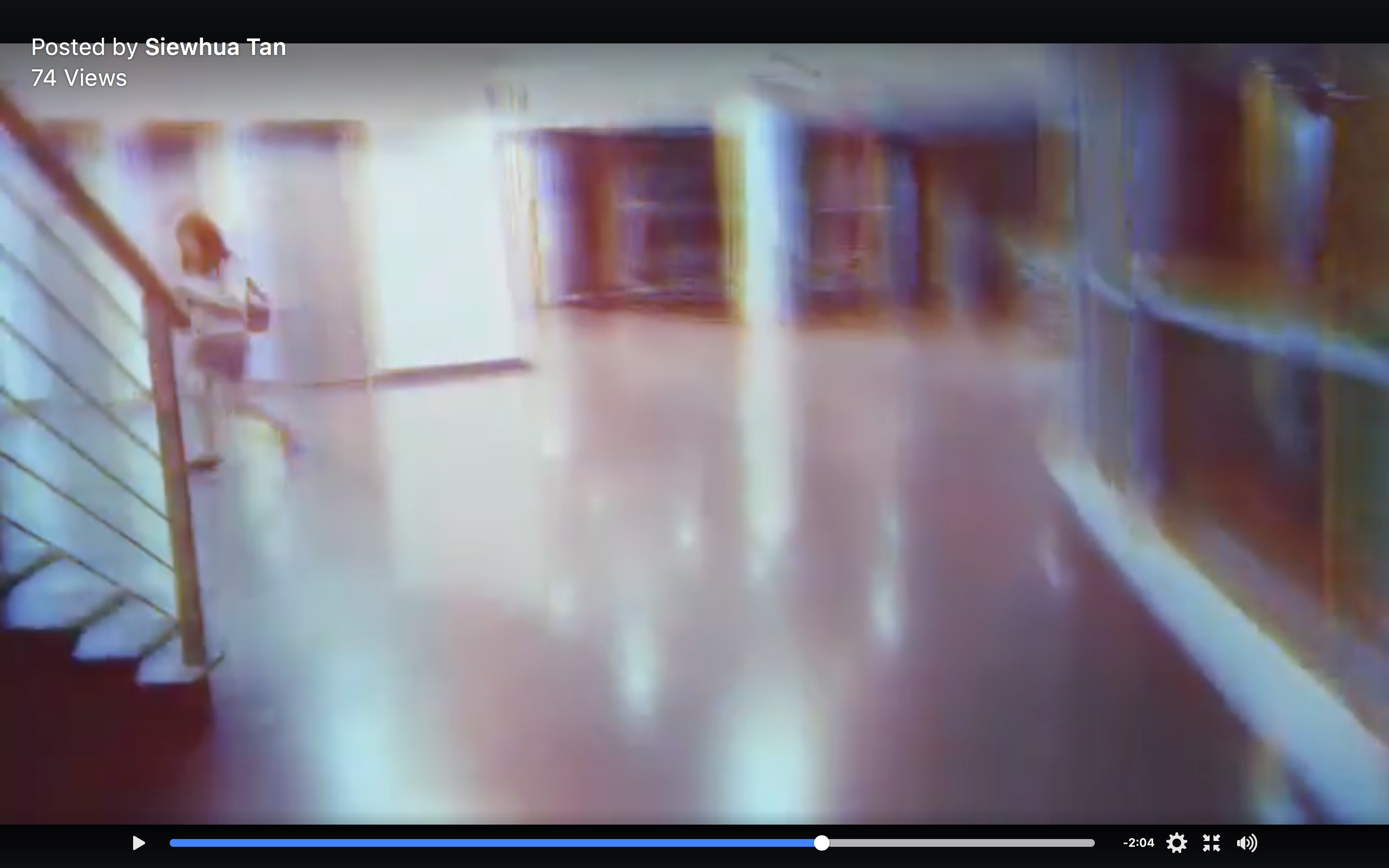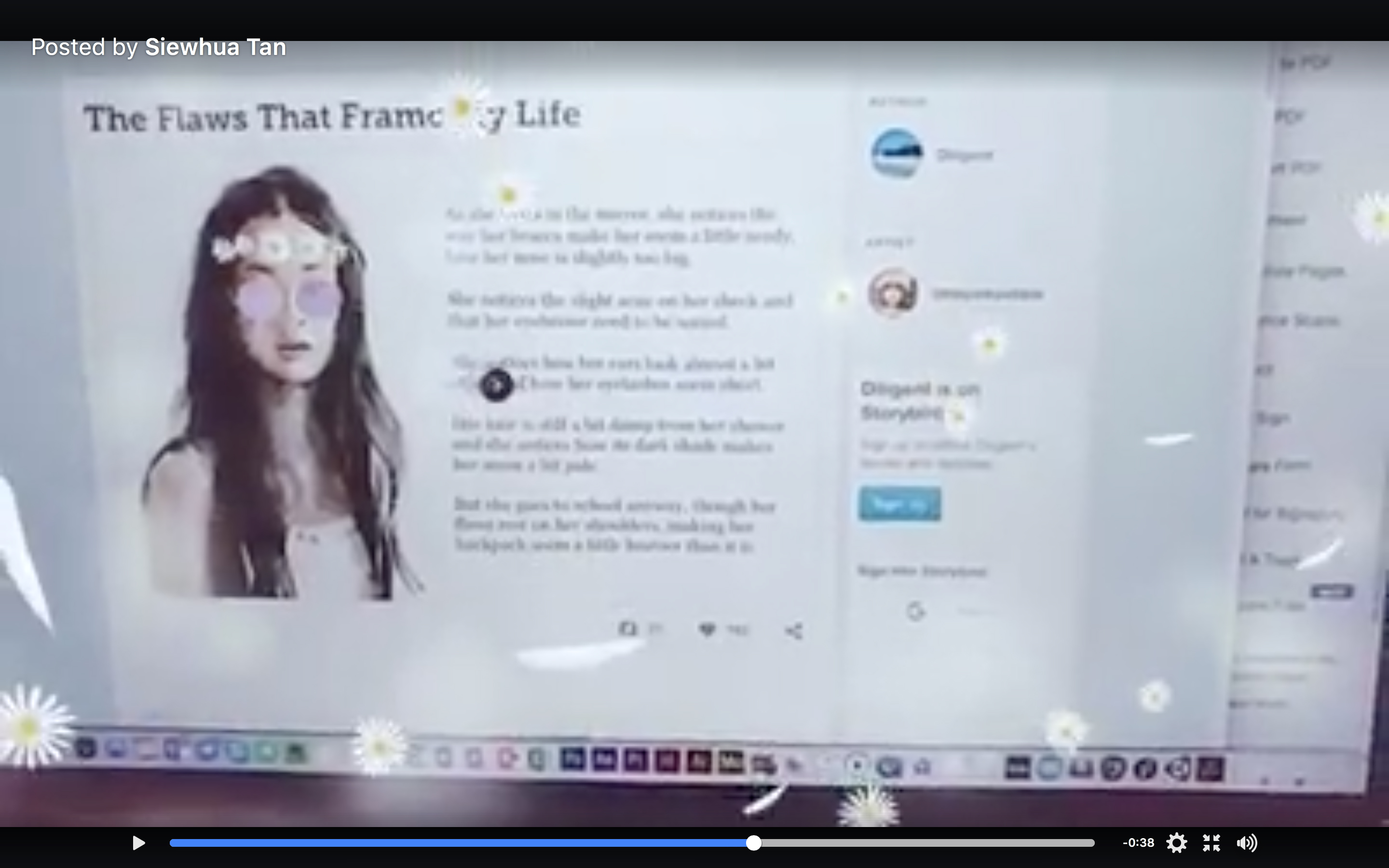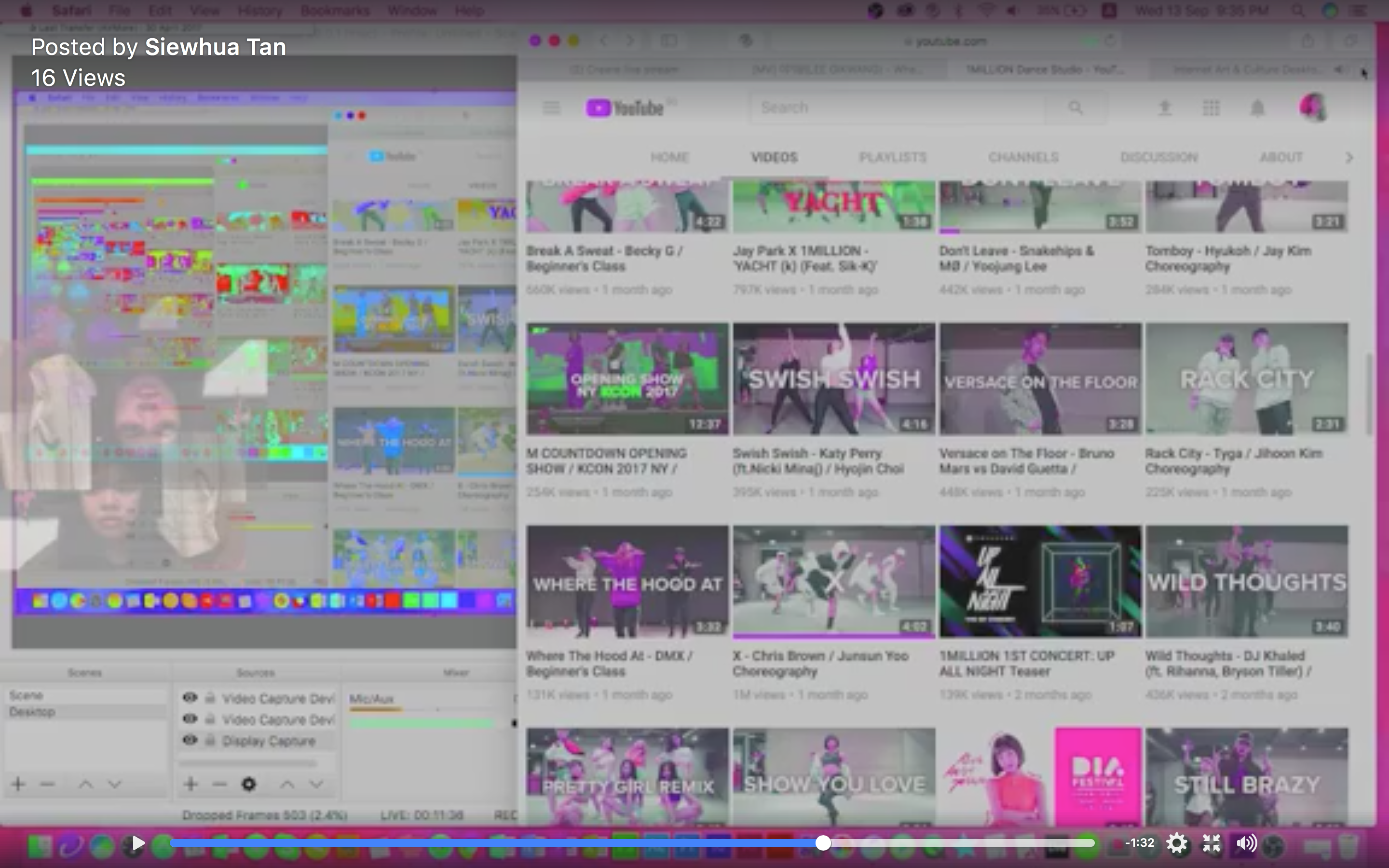The Death of Privacy ☠
by Third Front (Putri Dina, Siewhua Tan, Tiffany Rosete, Valerie Lay)
Final Live Broadcast:
Posted by Dina Anuar on Tuesday, 14 November 2017
Project Summary Description:
Our project aims to explore the boundaries of glitch, abstraction, disconnectivity & connectivity, distortion, latency and the frustrations of social broadcasting. Inspired by the television screens, each one of us has our own individual screens (top left: Siewhua, top right: Valerie, bottom left: Tiffany, bottom right: Dina). Taking on the topic of giving up of data, each of us are essentially doing so by sharing about ourselves online, by web browsing, skype calls, vlogs, etc.
The Roles:
Tiffany’s role is someone who decides to go on cam and talk about whatever she was feeling, doing at the moment and also interact with whoever that watches her.
Siewhua’s role is someone who also goes on cam but to broadcast her desktop activities. She realizes her friend, Tiffany who is also broadcasting now and decides to join in Tiffany’s broadcast simultaneously browsing through her facebook feed on her own broadcast. We decided to use facebook as a metaphor for data.
Valerie’s role is a masked character, called Scream who wants to teach people who give out too much data a lesson by disappearing them. Ironically, she herself is giving out data too.
Dina’s role acts like a control station and watches closely to the movements of each of our broadcasts while taking on a hidden identity by blending in with us by going on cam to vlog like Siewhua and Tiffany. She switches between screens at times and watches each broadcast individually and switches to another just as Scream strikes its victims. (Is this a act of hiding certain content that had gone wrong from the public?) Ultimately, she kills Scream but her hidden identity remains ambiguous as to whether she is a hero who killed the killer or was she the mastermind of everything where Scream was just a puppet of hers.
Side note: for a project that is all about glitch and disconnectivity, there was a lot of coordination and planning require in real life.
Contribution:
During the first brainstorm I came up with the ideas that was like a game #5 Telepathy Teamwork Game, #6 Fictionary / Word Bluff and one that was more artistic #7 Interpret-ception. Even though our final idea was formed from the second brainstorm (Glitchy old television screens), the syncing of same actions (#5 Telepathy Teamwork Game) was incorporated into the final broadcast during my co-broadcast with Tiffany.
I mainly contributed to the work mainly in the narrative of our piece, what are our roles and how the sequence of how the broadcast would go. Hence I was in charge of how the story goes and what each of us are, and how the whole broadcasting process would flow, from which screen to which. To draft things out better I did a few very rough storyboards trying out various type of narrative and sequence/flow.
Below is an image of the final storyboard that was agreed upon.
Using Facebook as a metaphor for giving up data, I created the desktop stream from OBS and adjusted the colours with colour correction to make it more saturated and vibrant and “unreal”. I then overlay a glitch green screen and lowered the opacity to about 30% to make the page more interesting and well, glitchy.
My part in the final broadcast was more significant in the starting where I’m live both from my laptop and on my phone (co-broadcasting with Tiffany).
Trial because I wanted to test whether it was possible:
Posted by Siewhua Tan on Tuesday, 14 November 2017
Posted by Tiffany Anne on Tuesday, 14 November 2017
And it works perfectly fine! YAY 😀
Moving on to the “death cams” (footage for after my disappearance):
Posted by Siewhua Tan on Tuesday, 14 November 2017
Death Cam Rehearsal Part 1
Posted by Siewhua Tan on Tuesday, 14 November 2017
Death Cam Rehearsal Part 2
Final (my individual part):
Posted by Siewhua Tan on Tuesday, 14 November 2017
(Part 1 – FB Browsing)
Posted by Siewhua Tan on Tuesday, 14 November 2017
(Part 2 – Death Cam)
Posted by Tiffany Anne on Tuesday, 14 November 2017
(and also with my fellow co-broadcaster, Tiffany)
I think we collaborated very well as team and I must say that our teamwork is really the key in our whole project. Even though our chosen concept was something that seemed full of errors, glitchy and disconnected at times, it may even seem unplanned or easy but in reality so much planning, coordination and teamwork was needed to achieve our outcome. For a work that is so full of imperfections we did so many rehearsals over and over again just to get it perfect. We honestly tried so hard to get the imperfections perfect. Ironic isn’t it? XD We also had to be very aware of each other’s movements and interactions with one another, from the small details to the obvious. It was honestly like a relay race going on from behind the scenes, because SURPRISE we were all in the same room! If we did not have such an awesome teamwork, from the careful passing of phones back and forth, resetting up the cams for “death cams” to the quiet prowl of Scream, I really think we would not have been able to make our project even work. So good job to us hehe! 😀
Influences:
The influence came mostly from Jon Cates and the Jennicam.
Our desktop is more than screen space, it is a virtual extension of our physical reality, a space for the formation and design of new identities, and an alternate world for artistic invention.
In BOLD3RRR, Jon Cates uses the technique of glitch to broadcast realtime where he fiddles around with the various softwares he use in his daily life with the overlay of sound and text simultaneously. Additionally, there is disruption and seemingly a lot of things going on at the same time. In our work, we utilised the glitch a lot and there was also many disruptions going on. The element of recursivities that is prominent in his work – a frontal view of Jon Cates in full screen but slightly fuzzy and blurry, text overlaying programs on screen and generally a very glitchy scape plus the strong buzzing of white noise is also prominent in our work where at times you see a frontal view of one of us, at times an overlay of Dina over one of our broadcasts and the four screens as a whole plus the occasional buzzing of static noise or glitchy voices. I also tried to show giving up of data with my Facebook account as a metaphor as well.
In Jennicam, which is focused on giving up her own data we tried to incorporate it by our own individual “vlogs” where we’re just doing our own things, in our own world before something unexpected strikes. Also, like the fans and haters of Jennicam, the actions of viewers ranges according to how they feel about this piece. You could remain anonymous and unknown to what others might be doing with the data you have given up. In our case, we decide to go play with the extremes of surveillance(Dina), killings because of hate(Valerie) and typical modern day users of the internet (me & Tiffany). We also played with the element of paranoia from the virtual world the had leaked into reality.
Conclusion:
Though the production of our final broadcast was rather tedious, it was actually quite fun and I enjoyed myself during the process of filming it. I think our rehearsals and tryouts can be slightly different each other even though we planned and already know what to do, which i think allowed for some surprises each time. I also think we improvised bit by bit, removing and adding elements accordingly to how our rehearsals went. Hence, i think our final result was mostly achieve due to planning but there were also some parts still left to chance. I think we explored a lot about the boundaries imperfections of social broadcasting and both the dark side(surveillance, anonymous, threats) and good(communication, connection with others) of it.
Our group’s fb group: https://www.facebook.com/groups/1140305776106354/?ref=br_rs
Document of the whole process: https://oss.adm.ntu.edu.sg/putridin001/2017/11/16/final-broadcast-the-death-of-privacy-by-third-front-for-presentation/
Group members: Me, Dina, TIffany, Valerie

















































